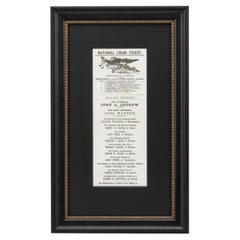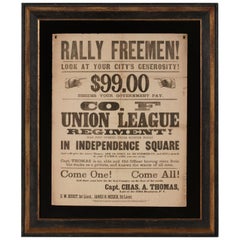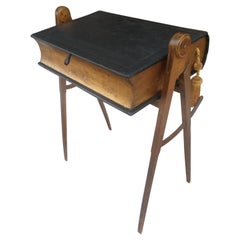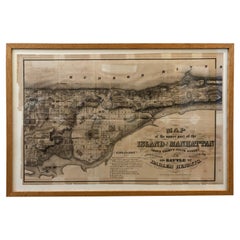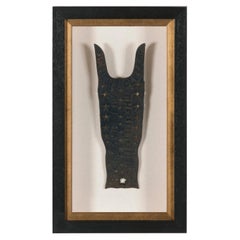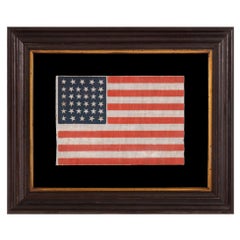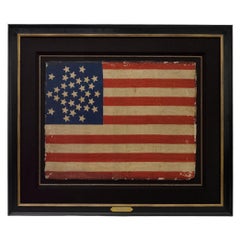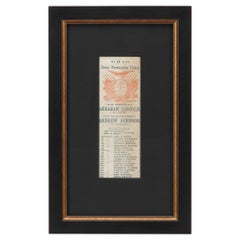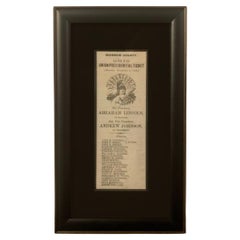1860s Political and Patriotic Memorabilia
to
1
20
20
1
8
115
108
3
44
42
12
4
11
3
4
7
3
3
4
3
1
13
10
5
1
1
19
18
20
20
20
Period: 1860s
1864 Lincoln & Johnson Boston Union Presidential Ticket
Located in Colorado Springs, CO
Presented is an original Massachusetts Union Presidential ticket for the November 8, 1864 election. The paper ticket is printed in black, headed by a large spreadwing eagle carrying ...
Category
Antique 1860s Political and Patriotic Memorabilia
Materials
Paper
"Rally Freemen!..." Civil War Recruitment Broadside
Located in York County, PA
"RALLY FREEMEN! …COME ONE! COME ALL! AND SHOW YOUR LOVE FOR THE BEST COUNTRY ON THE FACE OF THE EARTH." A CIVIL WAR RECRUITMENT BROADSIDE FOR THE...
Category
American Antique 1860s Political and Patriotic Memorabilia
Materials
Paper
19th Century Masonic Table with Leather Bible Compartment Flip Lid Compass Legs
Located in Port Jervis, NY
Rare and fabulous 19th century faux book with compass legs as legs. Mustard paint on the legs with Gilt on the pages of the leather bound book. Looks to be original tassle.. Possibly...
Category
American Folk Art Antique 1860s Political and Patriotic Memorabilia
Materials
Leather, Hardwood, Paint
$3,880 Sale Price
20% Off
1868 Map of the Upper Part of the Island of Manhattan Above 86th Street
Located in San Francisco, CA
This wonderful piece of New York City history is over 150 years old. It depicts 86th street and above. It was lithographed by WC Rogers and company. It was made to show what was the Battle of Harlem during the Revolutionary war...
Category
American American Colonial Antique 1860s Political and Patriotic Memorabilia
Materials
Paper
Cast Iron Boot Jack Made for 1864 Presidential Campaign of George McClellan
Located in York County, PA
CAST IRON BOOT JACK, MADE FOR THE 1864 PRESIDENTIAL CAMPAIGN OF GENERAL GEORGE B. MC CLELLAN, WITH A FANTASTIC SLOGAN THAT READS "THE UNION AT ALL HAZZARDS"
Made for the 1864 presidential run of George B. McClellan, this cast iron bootjack is both rare and graphically exceptional. Displaying the original black-painted surface, with attractive and desirable patina, the stylized profile has a wonderful folk art quality. Molded block letters that wrap around the heel clasp read simply "Gen. Mc Clellan. These are accompanied by a prominent Civil War-associated slogan: "The Union at all Hazards." The text is intermingled with 34 stars, which was equivalent to the number of states during the opening two years of the war, but was one star short by mid-1863 and two stars short by the time of the actual election in 1864. It's not unusual to encounter this feature in civil war campaign parade flags as well as all manner of flag-related ephemera.
The iron was reportedly cast by G. & D. Cross of Morrisville, New York, though it is unsigned and I have not yet verified the attribution. I have seen two other examples, one of which had a broken and repaired tine on the U-shaped horns and newly painted surface, while the other appeared to have broken lifters and inferior, rusted patina. This is, hands-down, the best of the identified examples.
Brief History of the 1864 Campaign:
President Abraham Lincoln had a checkered relationship with his 1864 opponent, who he had formerly chosen as General-in-Chief of the entire Union Army. The career officer repeatedly knocked heads with his Commander-in-Chief. Having raised a well-trained and organized military force, McClellan often seemed reluctant to use it. By 1862, after losses in Virginia during the Peninsula Campaign, Lincoln grew frustrated with McClellan and the progression of the war and removed him from command.
By the early part of 1864 the American people shared some of the same frustrations and Lincoln was no longer the clear choice for the White House. The nation was tired of war and the remains of the Democratic Party...
Category
American Antique 1860s Political and Patriotic Memorabilia
Materials
Iron
34 Star Antique American Parade Flag, Kansas Statehood, ca 1861-1863
Located in York County, PA
34 STARS, WITH SCATTERED POSITIONING, ON AN ANTIQUE AMERICAN PARADE FLAG MADE DURING THE OPENING TWO YEARS OF THE CIVIL WAR, 1861-63, KANSAS STATEHOOD
34 star American national flag...
Category
American Antique 1860s Political and Patriotic Memorabilia
Materials
Cotton
Price Upon Request
31 Star Parade Flag, Made for the 1860 Campaign of John Bell & Edward Everett
Located in York County, PA
31 STAR PARADE FLAG, MADE FOR THE 1860 CAMPAIGN OF JOHN BELL & EDWARD EVERETT, WITH A “UNION AND THE CONSTITUTION” SLOGAN, PROBABLY MADE BY H.C. HOWARD OF PHILADELPHIA
31 star Ameri...
Category
American Antique 1860s Political and Patriotic Memorabilia
Materials
Cotton
34 Star Antique American Parade Flag, Kansas Statehood, ca 1861-1863
Located in York County, PA
34 STAR ANTIQUE AMERICAN FLAG WITH A LINEAL ARRANGEMENT THAT I HAVE TERMED "GLOBAL ROWS, WITH EXCEPTIONAL COLOR AND CRUDE YET BEAUTIFUL FEATURES, OPENING TWO YEARS OF THE CIVIL WAR, ...
Category
American Antique 1860s Political and Patriotic Memorabilia
Materials
Cotton
Price Upon Request
35 Star Antique American Parade Flag, West Virginia Statehood, ca 1863-1865
Located in York County, PA
35 STAR ANTIQUE AMERICAN PARADE FLAG WITH A DOUBLE-WREATH STYLE MEDALLION CONFIGURATION OF STARS, PERHAPS THE BEST SURVIVING EXAMPLE IN THIS RARE FORM, CIVIL WAR PERIOD, WEST VIRGINI...
Category
American Antique 1860s Political and Patriotic Memorabilia
Materials
Cotton
34 Star Antique American Flag with Hourglass Medallion Stars, ca 1861-1863
Located in York County, PA
EXTRAORDINARY 34 STAR ANTIQUE AMERICAN FLAG WITH AN ACCORDION OR HOURGLASS MEDALLION CONFIGURATION THAT SURROUNDS A PENTAGON OF STARS IN THE CENTER; MADE OF FINE SILK AND ENTIRELY HAND-SEWN; MADE DURING THE OPENING YEARS OF THE CIVIL WAR (1861-63), IN A TINY SIZE AMONG ITS COUNTERPARTS OF THE PERIOD; REFLECTS THE ADDITION OF KANSAS AS THE 34TH STATE
34 star flag of the Civil War period with an array of rare, beautiful, and otherwise desirable features. Extremely small among flags of this period with pieced and sewn construction, the flag displays a star pattern that is not only highly unusual, but unique to this particular example. This consists of a single star in the very center, surrounded by a pentagon of stars, flanked by angular bracket of three stars to either side. Above and below are rows of 5 stars, followed by rows of 6 that line the top and bottom of the canton. The resulting configuration is what I have termed an “accordion medallion,” though “hourglass medallion” or “standing bow tie” would be perfectly acceptable.
When rotated 90 degrees, to view the harder-to-identify, bow tie formation, students of early star patterns may note the visual similarity between this and what I call “Starburst” or “Crosshatch” medallions. The pattern, however, conspicuously lacks the crosses of St. Andrew (a saltire) and St. George (roman cross), that would allow it to be more accurately categorized as such.
Entirely hand-sewn, the canton and stripes of the flag are made of fine silk. The hemming of this was accomplished with great skill. The top and bottom edges are selvedge. These are so similar in nature as to have come from the same maker. There is a white, silk binding along the hoist, in the form of an open sleeve, through which a length of braided hemp rope was passed, expertly looped and re-braided into itself at the top and bottom for strength.
The stars are made of white, polished cotton. These were stitched to both sides (double-appliqued). Note how the edges of the fabric were not turned under, providing evidence of the fact that the maker was not especially skilled in appliqueing. This was common, as applique work was far more difficult than producing French seams.
In the 19th century, most flags with pieced and sewn construction were 8 feet long and larger. A six-footer was considered small. Even military battle flags, carried on foot, measured 6’ x 6.5’, which translates into approximately 7’ x 7.5’ after framing, about the size of an average quilt and larger than can comfortably fit on a wall in a house with 8-foot ceilings and average width baseboard. Flags smaller than this were produced both commercially and at home, but the smaller they are, the more unusual they are. At just 26.5 x 46.5 inches, this flag is extremely small for a Civil war period flag with sewn construction.
Silk was both beautiful and lightweight, which made it elegant for military unit colors and preferable for flags meant to be carried on foot. Most outdoor use flags...
Category
American Antique 1860s Political and Patriotic Memorabilia
Materials
Silk
34 Star Antique American Parade Flag, Kansas Statehood, ca 1861-1863
Located in York County, PA
34 STARS IN A MEDALLION CONFIGURATION ON AN ANTIQUE AMERICAN PARADE FLAG WITH A LARGE, HALOED CENTER STAR; CIVIL WAR PERIOD, KANSAS STATEHOOD, 1861-1863
34 star American national pa...
Category
American Antique 1860s Political and Patriotic Memorabilia
Materials
Cotton
Price Upon Request
34 TUMBLING STARS on an ANTIQUE AMERICAN FLAG, CIVIL WAR PERIOD, 1861-63, KANSAS
Located in York County, PA
34 STARS WITH "DANCING" OR "TUMBLING" ORIENTATION, ON AN ANTIQUE AMERICAN FLAG WITH EXTRAORDINARY COLORS, PRESS-DYED ON WOOL BUNTING, LIKELY PRODUCED FOR USE AS MILITARY CAMP COLORS,...
Category
American Antique 1860s Political and Patriotic Memorabilia
Materials
Wool
34 STAR AMERICAN FLAG, CIVIL WAR, 1861-63, KANSAS STATEHOOD, 2nd KY CAVALRY
Located in York County, PA
34 STAR ANTIQUE AMERICAN FLAG OF THE CIVIL WAR PERIOD (1861-63), IN A TINY SCALE AMONG PIECED-AND-SEWN FLAGS OF THE PERIOD, WITH A TRIPLE-WREATH CONFIGURATION, AN ELONGATED FORMAT, AND ENTIRELY HAND-SEWN; FOUND WITH A LETTER FROM JOHN W. RUDE OF THE 2ND KENTUCKY VETERAN VOLUNTEER CAVALRY (UNION):
34 star flag of the Civil War period with a variety of extremely desirable features, handed down with a letter written by John W. Rude on November 8th, 1864, while encamped with the Army’s 1st Brigade, 3rd Division, as a member of the 2nd Regiment of Veteran Volunteer Cavalry. Tiny in scale among pieced and sewn examples, the flag displays a star pattern that consists of a three consecutive wreaths, with a single star in the very center. Because it lacks a single star in each corner, outside the basic pattern—usually present in flags of this design made during the mid-late 19th century—this is something I classify as a “snowball medallion.” Entirely hand-sewn throughout, note the square format of the blue canton, with its beautiful, circular star arrangement, and how interesting this combination is when paired with the elongated format of the flag itself. The stars are double-appliqued, meaning that they are applied to both sides. These are fat in shape and inconsistent in size. Note how the lowest star in the outermost ring actually dips into the white stripe below.
Made of plain weave cotton, there is a narrow binding along the hoist, red in color, with three sets of cotton ties. Those at the top and bottom are made of fine, braided hemp or hemp and cotton cord, stitched into place, while the one in the center, looped around the binding and tied, is made of lightweight, twisted, cotton thread. Note how the 5th, 6th, and 7th red stripes are pieced from two lengths of cotton fabric, which reflects that the maker was being conscious of conserving available fabric.
In the 19th century, most flags with pieced and sewn construction were 8 feet long and larger. A six-footer was considered small. Even military battle flags, carried on foot, measured 6’ x 6.5’, which translates into approximately 7’ x 7.5’ after framing, about the size of an average quilt and larger than can comfortably fit on a wall in a house with 8-foot ceilings and average width baseboard. Flags smaller than this exist, but the smaller they get, the more unusual they are. At just 1.5’ x 3’, this is about as small as one will ever encounter in a sewn flag of the Civil War era.
The flag appears to have likely been hand-carried. I expect that it probably saw military use of some sort as a camp flag...
Category
American Antique 1860s Political and Patriotic Memorabilia
Materials
Cotton
36 Star Antique American Parade Flag, with Canted Stars, ca 1864-1867
Located in York County, PA
36 STAR ANTIQUE AMERICAN PARADE FLAG WITH CANTED STARS IN DANCING ROWS, ON A BEAUTIFUL, CORNFLOWER BLUE CANTON; CIVIL WAR ERA, NEVADA STATEHOOD, 1864-1867
36 star antique American f...
Category
American Antique 1860s Political and Patriotic Memorabilia
Materials
Cotton
Price Upon Request
36 Star Antique American Flag, Cornflower blue Canton, circa 1864-1867, Nevada
Located in York County, PA
Antique American Flag With 36 Stars On A Cornflower Blue Canton, Civil War Era, 1864-1867, Reflects The Addition Of Nevada As The 36th State; A Great Folk Exaple With Haphazard Rows Of Starfish-like Stars:
36 star American national flag of the Civil War era with outstanding collector traits. Haphazard rows of fat, starfish-shaped stars fill most of the confines of a brilliant, cornflower blue canton. Note the crude piecing of the thirteen, red and white stripes, joined in an ill-planned manner that results in great variation in width, as well as general irregularity. The 4th red stripe actually falls slightly below the canton, and the height of each does not line up with the corresponding stripe on the reverse. This can clearly be seen at the fly end, which is is turned back and bound to repair obvious extended use in an outdoor environment. Clearly the maker lacked experience in seam work. Lining up the necessary components, so that they could be viewed on both sides, presented a challenge they may have not previously faced. This is also evident in the sewing of the stars, which do not line up on the obverse and reverse sides, as they typically would in a flag sewn by an experienced flag-maker. That said, this is just this kind of homemade charm that fuels interest in early American flags...
Category
American Antique 1860s Political and Patriotic Memorabilia
Materials
Cotton
1862 Civil War Playing Cards with Stars, Flag, Sheilds and Eagles
Located in York County, PA
1862 Civil War playing cards with stars, flags, shields, & eagles, and face cards illustrating civil war officers and lady, Columbia, ca 1862, Benjamin Hitchcock, New York
1862 Civil War playing cards with suits represented by stars, flags, shields, & eagles, in lieu of the traditional French suits of hearts, diamonds, clubs, and spades. The face cards feature Union Army officers and Lady Columbia [a.k.a. Lady Liberty, Goddess of Liberty]. Entitled “Union Playing Cards,” two versions of this deck were produced in New York by Benjamin W. Hitchcock’s “American Card Company.” This is the earlier of the two. The other was released in 1863.
There are 52 cards in total with the ace of spades doubling as the title card, as was often the case during the 19th century. The telescoping box...
Category
American Antique 1860s Political and Patriotic Memorabilia
Materials
Paper
Price Upon Request
Colorful Civil War Recruitment Broadside for the "Manhattan Rifles"
Located in York County, PA
MASSIVE & COLORFUL CIVIL WAR RECRUITMENT BROADSIDE FOR THE "MANHATTAN RIFLES,” WHICH MUSTERED INTO 43RD AND THE 57TH NEW YORK INFANTRY DIVISIONS ...
Category
American Antique 1860s Political and Patriotic Memorabilia
Materials
Paper
Price Upon Request
34 Stars in an Outstanding Oval Medallion Configuration, Civil War Period
Located in York County, PA
34 STARS IN AN OUTSTANDING OVAL MEDALLION CONFIGURATION, ON A NARROW CANTON THAT RESTS ON THE 6TH STRIPE, ON A HOMEMADE, ANTIQUE AMERICAN FLAG OF THE CIVIL WAR PERIOD, ENTIRELY HAND-...
Category
American Antique 1860s Political and Patriotic Memorabilia
Materials
Cotton
Hand-Painted 19th Century Banner with the 1867 Proposed Seal of Illinois
Located in York County, PA
HAND-PAINTED 19TH CENTURY BANNER WITH AN 1867 VERSION OF THE SEAL OF THE STATE OF ILLINOIS, PROPOSED IN THAT YEAR BY THE SECRETARY OF STATE, BUT IN A VARIATION NEVER FORMALLY ADOPTED
Banner with the Illinois State Seal, in a rare variation of the design, never adopted. In 1867 Illinois Secretary of State Sharon Tyndale proposed that the phrases in the state motto be reversed. In the wake of the Civil War, (which ended in 1865,) Tyndale suggested that the verbiage be changed from "State Sovereignty--National Union" to "National Union--State Sovereignty,” which made sense given the recent secession of the Southern States, which placed their own interests first. Illinois' own Abraham Lincoln had worked hard to preserve national interests, echoed here in the altering of the language. Though Tyndale’s suggestion was rejected, he was nonetheless charged with creating a new design, which he did and was soon adopted. This displayed the dates of "1818," when Illinois became a state, and "1868," when the seal was officially changed. Interestingly enough, Tyndale did manage to send a message in the new version by turning the word “sovereignty” upside-down , with the surmised explanation that this fit accordingly with the orientation / position of the streamer.
The banner is beautifully hand-painted on muslin and retains its original staff. The shape is beautifully scalloped at the bottom edge, which is painted to look as if there is an applied fringe. Most of the elements are congruent with the 1868 version, but there are various differences. Set within a shield-shaped medallion—usually circular—is the expected eagle in a side view, spread wing pose with beak uplifted. The eagle is supposed to be perched upon a rock with one talon, while gripping a Federal shield in the other. Here there is no rock and both talons grip the shield, which displays 13 stars. Note the date of "1867" and Tyndale's preferred order of the wording on the billowing ribbon in the eagle's beak. The foreground of the official design is all grass. Here there are olive branches—a peacetime reference appropriate for a country recovering from war—on a grassy area, set upon a sandy shore before Lake Michigan, with a rising sun on the horizon.
Mounting: The banner was mounted and framed within our own conservation department, which is led by masters degree trained staff. We take great care in the mounting and presentation of flags and have preserved thousands of examples; more than anyone worldwide.
The background is 100% cotton twill, black in color. The mount was placed in a black-painted, hand-gilded and distressed Italian molding. A shadowbox was created to accommodate the staff. The glazing is U.V. protective plexiglass. Feel free to contact us for more details.
Banner - 49" x 56.5"
Frame - 67.75" x 59.25"
About Jeff R. Bridgman Antiques, Inc.:
As an advisor to top museums and collectors alike, Jeff Bridgman is the world's leading expert and source for antique American flags and political textiles...
Category
American Antique 1860s Political and Patriotic Memorabilia
Materials
Cotton
Price Upon Request
Hand-Painted Patriotic Banner With The Seal of the State of Illinois
Located in York County, PA
HAND-PAINTED PATRIOTIC BANNER WITH THE SEAL OF THE STATE OF ILLINOIS AND GREAT FOLK QUALITIES PROBABLY MADE FOR THE 1868 DEMOCRAT NATIONAL CONVENTION...
Category
North American Antique 1860s Political and Patriotic Memorabilia
Materials
Canvas
Price Upon Request
Related Items
Mid-Century Table with Wheels, Italy, 19th Century
Located in Roma, IT
Mid-century table with wheels realized by italian manufactory in the mid-20th Century.
Central drawer.
Good condition.
Category
Italian Antique 1860s Political and Patriotic Memorabilia
Materials
Metal
31-Star Printed American Flag, Celebrating California Statehood, Circa 1850
Located in Colorado Springs, CO
This is a rare 31-star medallion printed American flag, celebrating the addition of California to the Union. The flag is printed on silk and has a spectacular “Great Star” canton pat...
Category
American Antique 1860s Political and Patriotic Memorabilia
Materials
Silk
$38,500
H 43 in W 50.5 in D 2.5 in
38-Star Antique American Flag with Unique Canton, circa 1876-1890
Located in Colorado Springs, CO
This is a striking 38-star American flag. The flag dates to 1876-1890, when Colorado (represented by the large star in the center of the flag’s canton) joined the Union as the 38th s...
Category
American Antique 1860s Political and Patriotic Memorabilia
Materials
Muslin
Centennial Celebration "1776-1876" American Flag Banner
Located in Colorado Springs, CO
Presented is a rare Centennial patriotic flag banner, dating to 1876. The flag’s brilliant blue canton is spectacular, with 81 five-pointed, rayed stars, arranged to read “1776” and “1876.” The flag’s design is completed with thirteen alternating red and white stripes. The flag is a three-piece, treadle-sewn sewn construction, printed on a thin wool and cotton blend. Along the edge, there is a narrow, treadle-sewn sleeve made of cotton tape.
In the lead up to the nation’s Centennial in 1876, flag makers and individuals looked to the past for designs to produce as part of the country’s many celebrations. Popular interpretation of the stars and stripes undoubtedly reached its climax of variety and originality at the time of our Nation’s first Centennial. Since no design restrictions were placed on flagmaker’s imaginations and no strict distinctions were drawn between official and unofficial star counts, it is no surprise that, on the occasion of the Centennial, creativity in flag design was not the exception, but the rule.
The cantons from this period presented an array of geometric abstractions. Great star patterns, referred to as the “starry flower of Liberty” by Oliver Wendell Holmes, that were popular from 1818 and on, resurfaced in Centennial flags...
Category
American Antique 1860s Political and Patriotic Memorabilia
Materials
Wool, Cotton
Barley Twist Leg Side Table or Desk, France, 19th Century
Located in New York, NY
19th century French barley twist legs desk.
Center drawer.
Decorative finial at cross stretcher local.
Brass pulls.
Can also be used as a sid...
Category
French Antique 1860s Political and Patriotic Memorabilia
Materials
Walnut
19th Century Console Table
Located in New York, NY
19th century Chinese console table. Three drawer thin console table elegant refined lines with ring pull handles. Detailed arch apron top of legs ta...
Category
Chinese Qing Antique 1860s Political and Patriotic Memorabilia
Materials
Elm
English 19th Century Mahogany Table with Compartment, Drawer and Reeded Legs
Located in Atlanta, GA
An English mahogany table from the 19th century, with single drawer, small compartment and reeded legs. Created in England during the 19th century, this mahogany table features a rectangular top with rounded corners and small compartment, sitting above a single drawer fitted with round beaded pulls. Raised on four reeded legs mounted on casters, this 19th century English mahogany table...
Category
English Antique 1860s Political and Patriotic Memorabilia
Materials
Brass
$6,550
H 29 in W 28 in D 20.75 in
19th Spanish Side Table with Cared Turned Legs and Iron Stretcher
Located in Miami, FL
19th Spanish side table with cared Solomonic turned legs and iron stretcher.
The top has a carved edges and a beautiful grain and patina.
Category
Spanish Baroque Antique 1860s Political and Patriotic Memorabilia
Materials
Iron
$2,590
H 25.4 in W 27.37 in D 19.49 in
Large Framed American Flag Folk Art Quilt
Located in Santa Monica, CA
Nicely faded American flag quilt. Excellent hand stitched dancing Folk Art stars. Skilled quilting, a nice graphic large-scale wall hanging. White ...
Category
North American Folk Art 1860s Political and Patriotic Memorabilia
Materials
Cotton
Votes for Women Parade Textile in Purple and Gren
Located in York County, PA
VOTES FOR WOMEN PARADE TEXTILE IN PURPLE AND GREEN, OF A TYPE WORN AS SASHES AND WAVED AS NARROW PARADE BANNERS, MADE IN HARTFORD, CONNECTICUT BY CALHOUN PRESS FOR THE WOMEN'S POLITI...
Category
American 1860s Political and Patriotic Memorabilia
Materials
Cotton
19th Spanish Side Table with Cared Turned Legs and Iron Stretcher
Located in Miami, FL
19th Spanish side table with turned legs and iron stretcher.
The top has a beautiful grain and patina.
Category
Spanish Baroque Antique 1860s Political and Patriotic Memorabilia
Materials
Iron
$1,475
H 20.08 in W 19.49 in D 15.56 in
Walnut Side Table 19th Century, Italy, 19th Century
Located in Roma, IT
Walnut Side Table 19th Century realized by an italian manufacture in 19th Century.
Good overall condition.
Category
Italian Antique 1860s Political and Patriotic Memorabilia
Materials
Metal
$391 Sale Price
30% Off
H 30.52 in W 18.9 in D 28.35 in
Previously Available Items
1864 Lincoln & Johnson Ohio Union Presidential Ticket
Located in Colorado Springs, CO
Presented is an original Ohio Union Presidential ticket for the November 8, 1864 election. The paper ticket is printed in orange-red and blue. The front of the ticket reads, "A Vigor...
Category
American Antique 1860s Political and Patriotic Memorabilia
Materials
Paper
1864 Abraham Lincoln Presidential Election Soldier's Ballot
Located in Colorado Springs, CO
Presented is an original soldier’s ballot for the 1864 American presidential election. The ballot is from Binton County, Ohio. The paper ticket is printed with an allegorical represe...
Category
American Antique 1860s Political and Patriotic Memorabilia
Materials
Paper
13-Star American Parade Flag, 1860
Located in Colorado Springs, CO
Presented is a stunning 13-star American parade flag, dating to 1860. The wool flag has 13 hand-sewn cotton stars with truncated tips. The stars are configured in the “Third Maryland” or “Cowpens” pattern, consisting of a 12-star wreath surrounding a large central star. The flag design is completed with 13 red and white alternating stripes and a white cotton hoist. The flag’s hoist has “Lafayette Post 140” stenciled in selvage.
The “Third Maryland” star pattern of a 12-star wreath surrounding a central star is associated with an early 13-star flag that was long thought to have been carried by William Batchelor of the 3rd Maryland Regiment at the Battle of Cowpens during the American Revolution. The flag, now in the collection of the Maryland State Archives, was later discovered by Smithosian experts to date to the mid-19th century. But this particular star pattern is forever linked to that particular 13-star flag and the wreath and central star configuration is still referred to as a “Third Maryland” or “Cowpens” style among dealers and collectors. Thirteen star flags with the “Third Maryland” pattern are among the scarcest and most desired by collectors of early American flag...
Category
American Federal Antique 1860s Political and Patriotic Memorabilia
Materials
Wool, Cotton
Civil War Apron, Made In Cambridge, OH by Laura, Hynes, ca 1861
Located in York County, PA
CIVIL WAR PERIOD APRON, MADE IN CAMBRIDGE, OHIO IN 1861 BY 12-YEAR-OLD LAURA HAYNES, WORN BY HER AT BENEFITS FOR THE U.S. SANITARY COMMISSION, PREDECESSOR OF THE RED CROSS, THAT STAFFED, FUNDED, AND MODERNIZED CIVIL WAR HOSPITALS
Laura Haynes was born on the 17th of June, 1847 to Vincent and Sarah (Dillon) Haynes of Westland, Ohio (southeast of Columbus and due south of Zanesville). Vincent was listed as a physician in the 1850 U.S. Census, then as a lawyer in 1860, apparently having pursued both fields. It stands to reason that that during the Civil War (1861-1865), the Haynes family, being of means and with Vincent involved in the medical profession, might become involved in philanthropy to benefit Civil War hospitals.
Made of plain weave cotton, this patriotic apron features 18 white, appliquéd, hand-sewn stars on a blue ground, cinched at the waist, with a blue belt incorporated below, followed by 13 vertical stripes, alternating red and white, likewise cinched, so that top and bottom have opposing triangular profiles. Aprons of this period did not generally have a loop or tie that went about the neck, to keep the breast portion up, but were rather pinned in place. All of the construction was accomplished by hand-stitching. One can see in the more crude stitching of the stars, how much more difficult it was to perform appliqué work than it was to hem fabric, especially for a 12-year-old girl.
While the count of 18 stars may have had no purpose other than to fill the available space, to create a patriotic display, it may just as likely have been selected to reflect the number of states that were felt to be loyal to the Union at the time. Until July 4th, 1861, there were officially 33 stars on the American national flag. This, less the entire complement of 15 Slave States, would arrive at a count of 18. President Abraham Lincoln urged the nation not to do this, desiring not to give credence to secession, with his goal of keeping the Union together. But there were no flag police and people did as they wished, creating versions of the Stars & Stripes in both the North and the South that removed those the respective maker(s) deemed loyal to the opposition. Although rare, a number of American flags of the Civil War era are known that display 18 stars, likely to reflect the removal of 15 Southern States.
In the upper center of the striped portion of the apron is a fraternal ribbon, made of blue satin silk, with a white metal brooch at the top and a gold button with an eagle below. This is decorated with a printed 13 star flag ribbon (applied), and with gilded text that reads: “The Women and Girl Workers of the Civil War; ’61-’65.” Next to this is the membership badge of the Women’s Relief Corp, which served as the women’s auxiliary of the Grand Army of the Republic, the primary organization for Civil War veterans. Below these, a hand-lettered exhibition tag was adhered, that reads as follows: “Made in 1861 at Cambridge Ohio by Laura Haynes; Age 12 Years; and Worn at Benefits for the Sanitary Commission [The Red Cross of 1861-5],” Followed by “Laura H. Green; Hotel St Mark; Oakland Calf.” Along the bottom of the tag is a brief title: “Flag-Apron of 1861-5,” with a circled item number “27.”
The Sanitary Commission was founded in the Spring of 1861 by private citizens in New York City, who were appalled by the Army’s lack of medical supplies and sanitary conditions in the care of Civil War soldiers. Officially sanctioned by the War Department on June 9th of that year, and approved by Abraham Lincoln on June 13th, the chief planner and organizer was Boston-born writer and Harvard-educated clergyman, Henry Whitney Bellows of New York (b. 1814, d. 1882). Bellows modeled the organization after the work of Florence Nightingale in the British Sanitary Commission of the 1850’s, and brought with him a force of volunteers belonging to an organization he led called the Woman’s Central Association of Relief of New York. In 1863, Bellows would become one of the four founders of the Union League Club of New York, with fellow Sanitary Commission leaders Frederick Law Olmsted (the designer of Central Park, considered to be the father of modern landscape architecture,) plus George Templeton Strong (American composer, painter, lawyer, and prolific diarist), and Oliver Wolcott Gibbs (Harvard professor, chemist, and physician). The goal of the Union League Club was to join like-minded and influential, moneyed men with the cause of both the Commission and the Union in general. In 1881, Sanitary Commission nurse Clara Barton would carry the torch forward, expanding upon the concept to form the Red Cross.
Sanitary Fairs—large, fundraising events held to benefit the Commission—were held in New York, Philadelphia, Baltimore, Chicago, St. Louis, and elsewhere. The Northern Ohio Sanitary Fair was almost certainly attended by Laura Haynes, 16 years old by that time, who is likely to have worn the apron there. Held in Cleveland from Feb. 22nd – Mar. 10th, 1864, the fair was opened by Major General James Garfield, future President of the United States, who, it is said, was extremely well received.
About 3 years later, on June 11th, 1868, Laura married Robert M. Green of Cambridge, Ohio (northeast of Westland), who shared her June 17th birthday. Born 2 years prior to Laura, in 1846, Robert enlisted as a Corporal with “A” company of the 85th Ohio Infantry, a 3-month unit, on May 27th, 1862. Mustering in on June 10th, I Columbus, at Camp Chase, the 85th was assigned to guard Confederate prisoners at the garrison. He mustered out on the 23rd of September.
By 1880, Robert & Laura Green had relocated to Oroville, California (Butte County...
Category
American Antique 1860s Political and Patriotic Memorabilia
Materials
Cotton
36-Star Printed American Flag, Rare Haloed Star Medallion, Circa 1865
Located in Colorado Springs, CO
This 36-star flag has stars arranged in a gorgeous and highly desirable medallion pattern. This particular medallion includes a large haloed star in the middle, two rings of stars s...
Category
American Antique 1860s Political and Patriotic Memorabilia
Materials
Fabric
36-Star Civil War Flag, Circa 1864-65
Located in Colorado Springs, CO
This is a 36-star hand-sewn antique flag, as striking as it is scarce. 36 stars celebrate the addition of Nevada to the Union and officially flew from July 4, 1865 to July 3, 1867, u...
Category
American Antique 1860s Political and Patriotic Memorabilia
Materials
Fabric
34 STAR AMERICAN FLAG, CIVIL WAR PERIOD, 1861-63, a RARE STYLE, KANSAS STATEHOOD
Located in York County, PA
34 STARS IN 4 ROWS WITH 2 STARS OFFSET AT THE HOIST END, ON AN ANTIQUE AMERICAN FLAG LIKELY PRODUCED FOR MILITARY FUNCTION, AS UNION ARMY CAMP COLORS; ONE OF JUST A TINY HANDFUL THAT I HAVE ENCOUNTERED IN THIS EXACT STYLE, REFLECTS KANSAS STATEHOOD, OPENING TWO YEARS OF THE CIVIL WAR...
Category
American Antique 1860s Political and Patriotic Memorabilia
Materials
Wool, Cotton
H 33.25 in W 57.5 in D 2.5 in
34 Star Antique American flag, Kansas Statehood, Civil War Period, ca 1861-1863
Located in York County, PA
34 STAR ANTIQUE AMERICAN FLAG OF THE CIVIL WAR PERIOD (1861-63), WITH WOVEN STRIPES, PRESS-DYED STARS, AND BEAUTIFUL COLORS, POSSIBLY MADE IN NEW YORK BY THE ANNIN COMPANY, REFLECTS THE ADDITION OF KANSAS TO THE UNION, 1861-1863
34 star flag of the Civil War period, with a press-dyed canton and woven stripes. Made of a fabric produced frame a combination of wool and cotton fibers, the 34 star count was achieved in an unusual fashion, beginning with a press-dyed field of 32 star...
Category
American Antique 1860s Political and Patriotic Memorabilia
Materials
Cotton
H 53 in W 94 in D 2.5 in
35-Star Hand-Cut American Civil-War Era Flag, circa 1863
Located in Colorado Springs, CO
This is a beautifully hand-cut and sewn 35-star American flag, representing the addition of West Virginia to the Union. West Virginia joined the Union on June 20, 1863. Because 35-st...
Category
American Antique 1860s Political and Patriotic Memorabilia
Materials
Wool, Canvas
34 Star Flag with Stars in a Rare Pattern, Huge Center Star, Kansas Statehood
Located in York County, PA
34 STARS IN A VERY RARE PATTERN THAT FEATURES A HUGE CENTER STAR IN THE MIDST OF A LINEAL STAR PATTERN, ONE-OF-A-KIND AMONG KNOWN EXAMPLES, CIVIL WAR PERIOD, 1861-63, KANSAS STATEHOOD
Early flags are collected for many reasons, but one of the primary factors can be found in the mere fact that they looked so very different in early America than they do today. Because there was no official star configuration for the American national flag until 1912, their design was left to the whims of the flag-maker. Artist’s liberty and creative expression led to a host of various star patterns. Among these are not only rows and columns of stars, but circular formations, star-shaped formations, and all manner of other arrangements that span from the common and benign to the exceptionally rare and whimsical.
One of the earliest concepts in the layout of the stars was to feature a large one in the center of the blue canton amidst an otherwise lineal configuration. Because so few flags survive from the first fifty years following our independence, scant few examples exist with this feature, but it can be seen on the only known 17-star, 17-stripe flag (1803-1812), for example, that has so-far been discovered, as well as a fragment of the another flag that was found alongside it. It can also be seen on a rare, 24-star example (1821-1836), as well as a particular early, 13-star flag that probably pre-dates 1830 and might be 18th century.
In the case of printed parade flags, like this one, I can think of only two examples, each of which survives as the only known flag in its respective style. Neither of these has thus far been documented in any text.
This is one of those two, exceptionally rare flags...
Category
American Antique 1860s Political and Patriotic Memorabilia
Materials
Cotton
H 30.5 in W 40 in D 2.5 in
13 Star Antique American Flag with Hand-Sewn Stars in 5-3-5 Pattern, ca 1861-65
Located in York County, PA
Antique American flag with 13 hand-sewn stars in an extremely rare lineal configuration of 5-3-5, probably made with the intent of use by local militia or private outfitting of a vol...
Category
American Antique 1860s Political and Patriotic Memorabilia
Materials
Wool
H 48 in W 65.5 in D 2.5 in
13 Star Antique American Flag in the Betsy Ross Pattern, circa 1861-1865
Located in York County, PA
13 star antique American flag in the Betsy Ross pattern, one of just three examples that I have encountered that pre-date the 1890’s; an extraordinary find, civil war period (1861-1865) or just after, extremely large among its counterparts of all periods in this design:
Exceptional, early, American national flag, with 13 stars arranged in the circular wreath pattern most often attributed to Betsy Ross. Since there was no official configuration for the stars of the American flag until 1912, when our nation received its 47th and 48th states, the design, before that time, was left to the whims of the maker. This led to an almost unimaginable spectrum of star arrangements on the American flag during the 18th and 19th centuries. Even within the 13 star count, alone, there are at least 80 known patterns—more than the average person would even think possible.
13 star flags have been made throughout American history, from at least June 14th, 1777, when the first Flag Act was passed by Congress, until the present. They have been continuously produced for reasons both patriotic and utilitarian. Because this was the original number of stars on the American flag, representing the 13 colonies, it was appropriate for any device made in conjunction with celebrations or notions of American independence. 13 star flags were thus displayed at patriotic events, including, but certainly not limited to, such occasions as Lafayette’s final visit, in 1825-26, the nation’s centennial in 1876, and longstanding celebrations of Independence Day. From at least 1840 onward, 13 star flags were produced for presidential campaigns, drawing a parallel between the past and present struggles for freedom, and were carried by soldiers, during the Mexican and Civil Wars, for the same purpose. Throughout history, and even today, they are boldly displayed at every presidential inauguration.
13 star flags were flown by American ships both private and federal. The U.S. Navy used 13 stars on the ensigns made for small boats, because they wished the stars to be more easily discernable at a distance. Private ships often copied Navy practice, and when commercial flag makers first began to produce flags with pieced-and-sewn construction, in small sizes, in large quantity, they frequently employed the 13 star count.
Flags in the Betsy Ross design are widely admired, due to the longstanding popularity of the Ross family myth. While many Americans learned in grammar school that Betsy Ross made and designed our first flag, and that the stars appeared in a circular fashion, there is, unfortunately, no way to prove the claim. No colonial examples have survived with this pattern of stars. In fact, while arranging the stars in a single circle seems quite logical, among the various choices that might come to mind, early American flags with this star pattern are curiously absent. One of the interesting misconceptions about 13 star flags is that the Betsy Ross pattern, even if not the original design, must have been common in early America. Logic would suggest this, given the frequency with which it appears in modern times, but this isn’t actually the case. In fact, the pattern is seldom encountered anywhere until much later. In more than 30 years of buying and selling early Americana, and over 20 years of extensive focus on the American flag specifically, through aggressively buying, researching, evaluating, restoring, and curating exhibitions, I have thus far encountered just three examples of Betsy Ross pattern flags that I can confidently date prior to the 1890's.
No one knows what the first flag looked like. While there is no precise reason that the Betsy Ross design could not have been the first, one of the best arguments against it, is illustrated by the simple fact that so many 13 star flags exist without it. If the Ross configuration was the original, it stands to reason that the pattern would have been reproduced with at least some degree of frequency.
Research conducted by the National Museum of American History notes that the story of Betsy Ross making the very first American flag for General George Washington, in the company of George Ross and Robert Morris, entered into American consciousness about the time of the 1876 centennial. The tale was immensely popular among an American public eager for stories about the Revolution and its heroes. The first documentation of it appeared shortly beforehand, in 1870, in a paper written by Betsy’s grandson, William Canby, for the Pennsylvania Historical Society. At the time, Canby made no mention of how the flag was designed, save for the fact that it had 5-pointed stars, per his grandmother’s suggestion. Because no earlier documentation supports the story, most flag scholars feel it was a grand hoax, fabricated by Canby for his own interests. Nothing survives in the collective writings of the three men, for example, nor in records of their words and deeds, which are fairly extensive. As with most things, reality is perhaps somewhere in the middle ground, with some of the details based on fact and some on fiction, made up, misinterpreted, or imagined from family accounts.
The first time that a star configuration gets attached to the Ross story appears to have occurred during the last decade of the 19th century. In 1892, Charles Weisgerber painted a nine-by-twelve-foot rendition of the fabled meeting between Betsy and George Washington, in which there is a flag with a circular wreath. Shortly afterwards, in 1898, Betsy’s granddaughter and great-granddaughter began to make flags in the East Wing of Independence Hall in Philadelphia, selling them to tourists while disseminating the family folk tale. In that same year, Weisgerber and a “group of concerned citizens” sought to preserve Betsy’s former Philadelphia residence at 239 Arch Street, where she lived at the time the flag would have been sewed. Weisgerber moved his family into the house and immediately opened to the public the room in which Betsy was said to have worked her magic. Ten-cent memberships were sold to fund renovations and donors received a small calendar, to which a cotton 13 star Betsy Ross pattern parade flag was affixed. The effects of these events caused the Ross legend to stick and the story, with the corresponding flag design, has appeared ever since in more places than one could ever hope to count.
The stars of this particular flag are made of cotton, hand-sewn, and double-appliquéd (applied to both sides). The canton and stripes of the flag are made of wool bunting that has been pieced and joined with treadle stitching. There is a sailcloth canvas binding along the hoist, with two brass grommets, one each at the extreme top and bottom. Along this, on the obverse, near the bottom, are two, unusual characters, embroidered with brown thread. These may be letter “I’s,” possibly forming a the Roman Numeral “II.” They are followed by an inscription, in blue ink, that appears to read “A. N. Smith.” The first character is stylized, and may alternatively be a “D,” “H,” or perhaps a “J.” Note how the binding is extended beyond the top and bottom-most points. Though quite unusual, this is sometimes encountered in early examples. The folding of the wool bunting back onto itself, with the binding stitched so that part of the fold is exposed, tends to be an early characteristic. Common in Civil war flags...
Category
American Antique 1860s Political and Patriotic Memorabilia
Materials
Cotton
Recently Viewed
View AllMore Ways To Browse
20 Star Flag
Antique Rope Machine
James Harrison
37 Star Flag
Black Americana Memorabilia
Sumter Furniture
Tennessee Antiques
Abraham Lincoln Antique
Montana Flag
Patriotic Drum
Side Show Banner
18th Century Wash Stand
45 Star Flag
Antique 48 Star Flag
Felt Pennant
Forbidden Stitch
Japanese World War Flag
40 Star American Flag
